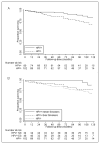Low risk of second primary malignancies among never smokers with human papillomavirus-associated index oropharyngeal cancers
- PMID: 22711172
- PMCID: PMC3459137
- DOI: 10.1002/hed.23033
Low risk of second primary malignancies among never smokers with human papillomavirus-associated index oropharyngeal cancers
Abstract
Background: Among patients with index oropharyngeal cancer, second primary malignancies (SPMs) may be less common in cases of human papillomavirus (HPV)-associated tumors than HPV-negative tumors. Further modification of these SPM risks by smoking has not been reported.
Methods: SPM outcomes of 356 patients with incident oropharyngeal cancer were analyzed using Cox proportional hazards and Kaplan-Meier models. SPM risk and SPM-free survival were compared in HPV-seronegative patients, HPV-seropositive never smokers, and HPV-seropositive ever smokers.
Results: HPV-seropositive patients had a lower 5-year SPM rate than HPV-seronegative patients (5.6% vs 14.6%; p = .051). Compared to HPV-seronegative patients, HPV-seropositive never smokers had a 73% reduced SPM risk, and HPV-seropositive ever smokers had a 27% reduced SPM risk (trend p = .028). Although HPV-seronegative patients had SPMs in traditional locations, 70% of SPMs among HPV-seropositive patients were outside typical tobacco-related sites.
Conclusion: HPV serologic status and smoking may stratify patients with index oropharyngeal cancers in terms of risk and location of SPMs.
Copyright © 2012 Wiley Periodicals, Inc.
Figures
Similar articles
-
Synchronous cancers in patients with head and neck cancer: risks in the era of human papillomavirus-associated oropharyngeal cancer.Cancer. 2013 May 15;119(10):1832-7. doi: 10.1002/cncr.27988. Epub 2013 Feb 19. Cancer. 2013. PMID: 23423883
-
Incidence and pattern of second primary malignancies in patients with index oropharyngeal cancers versus index nonoropharyngeal head and neck cancers.Cancer. 2013 Jul 15;119(14):2593-601. doi: 10.1002/cncr.28107. Epub 2013 Apr 19. Cancer. 2013. PMID: 23605777 Free PMC article.
-
Second primary cancers after an index head and neck cancer: subsite-specific trends in the era of human papillomavirus-associated oropharyngeal cancer.J Clin Oncol. 2011 Feb 20;29(6):739-46. doi: 10.1200/JCO.2010.31.8311. Epub 2010 Dec 28. J Clin Oncol. 2011. PMID: 21189382 Free PMC article.
-
Systematic review on location and timing of distant progression in human papillomavirus-positive and human papillomavirus-negative oropharyngeal squamous cell carcinomas.Head Neck. 2019 Mar;41(3):793-798. doi: 10.1002/hed.25458. Epub 2018 Dec 23. Head Neck. 2019. PMID: 30582231
-
Human papillomavirus (HPV) and oropharyngeal squamous cell carcinoma.Presse Med. 2014 Dec;43(12 Pt 2):e429-34. doi: 10.1016/j.lpm.2014.08.010. Epub 2014 Nov 11. Presse Med. 2014. PMID: 25455638 Review.
Cited by
-
Surgery Versus Radiotherapy for Early Oropharyngeal Tumors: a Never-Ending Debate.Curr Treat Options Oncol. 2015 Sep;16(9):42. doi: 10.1007/s11864-015-0362-4. Curr Treat Options Oncol. 2015. PMID: 26187797 Review.
-
Risk of second primary cancer in patients with head and neck squamous cell carcinoma: a systemic review and meta-analysis.Clin Oral Investig. 2023 Sep;27(9):4897-4910. doi: 10.1007/s00784-023-05066-3. Epub 2023 Aug 4. Clin Oral Investig. 2023. PMID: 37540282
-
Role of 18F-FDG PET/CT in Head and Neck Squamous Cell Carcinoma: Current Evidence and Innovative Applications.Cancers (Basel). 2024 May 16;16(10):1905. doi: 10.3390/cancers16101905. Cancers (Basel). 2024. PMID: 38791983 Free PMC article. Review.
-
Is there a patient population with squamous cell carcinoma of the head and neck region who might benefit from de-intensification of postoperative radiotherapy? : A monocentric retrospective analysis of a previously defined low-risk patient population treated with standard-of-care radiotherapy.Strahlenther Onkol. 2019 Jun;195(6):482-495. doi: 10.1007/s00066-018-1415-y. Epub 2019 Jan 4. Strahlenther Onkol. 2019. PMID: 30610355 English.
-
Oral and periodontal manifestation related during human papilloma virus infections: Update on early prognostic factors.Heliyon. 2024 May 14;10(10):e31061. doi: 10.1016/j.heliyon.2024.e31061. eCollection 2024 May 30. Heliyon. 2024. PMID: 38813162 Free PMC article. Review.
References
-
- Parkin DM, Bray F, Ferlay J, Pisani P. Global cancer statistics, 2002. CA Cancer J Clin. 2005;55(2):74–108. - PubMed
-
- Sturgis EM, Miller RH. Second primary malignancies in the head and neck cancer patient. Ann Otol Rhinol Laryngol. 1995;104(12):946–954. - PubMed
-
- Bhattacharyya N, Nayak VK. Survival outcomes for second primary head and neck cancer: a matched analysis. Otolaryngology Head Neck Surg. 2005;132(1):63–68. - PubMed
-
- Yamamoto E, Shibuya H, Yoshimura R-ichi, Miura M. Site specific dependency of second primary cancer in early stage head and neck squamous cell carcinoma. Cancer. 2002;94(7):2007–2014. - PubMed
Publication types
MeSH terms
Substances
Grants and funding
LinkOut - more resources
Full Text Sources


